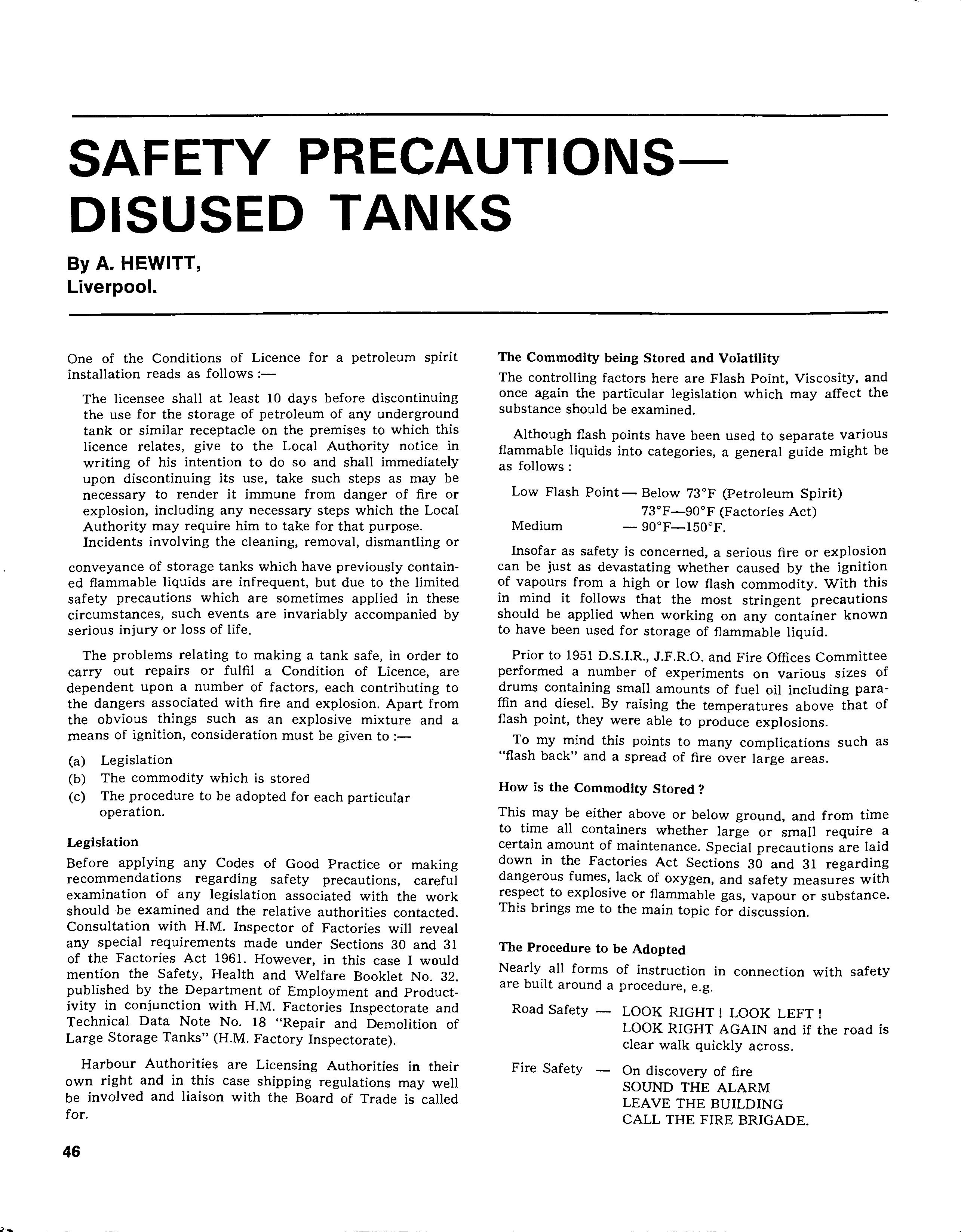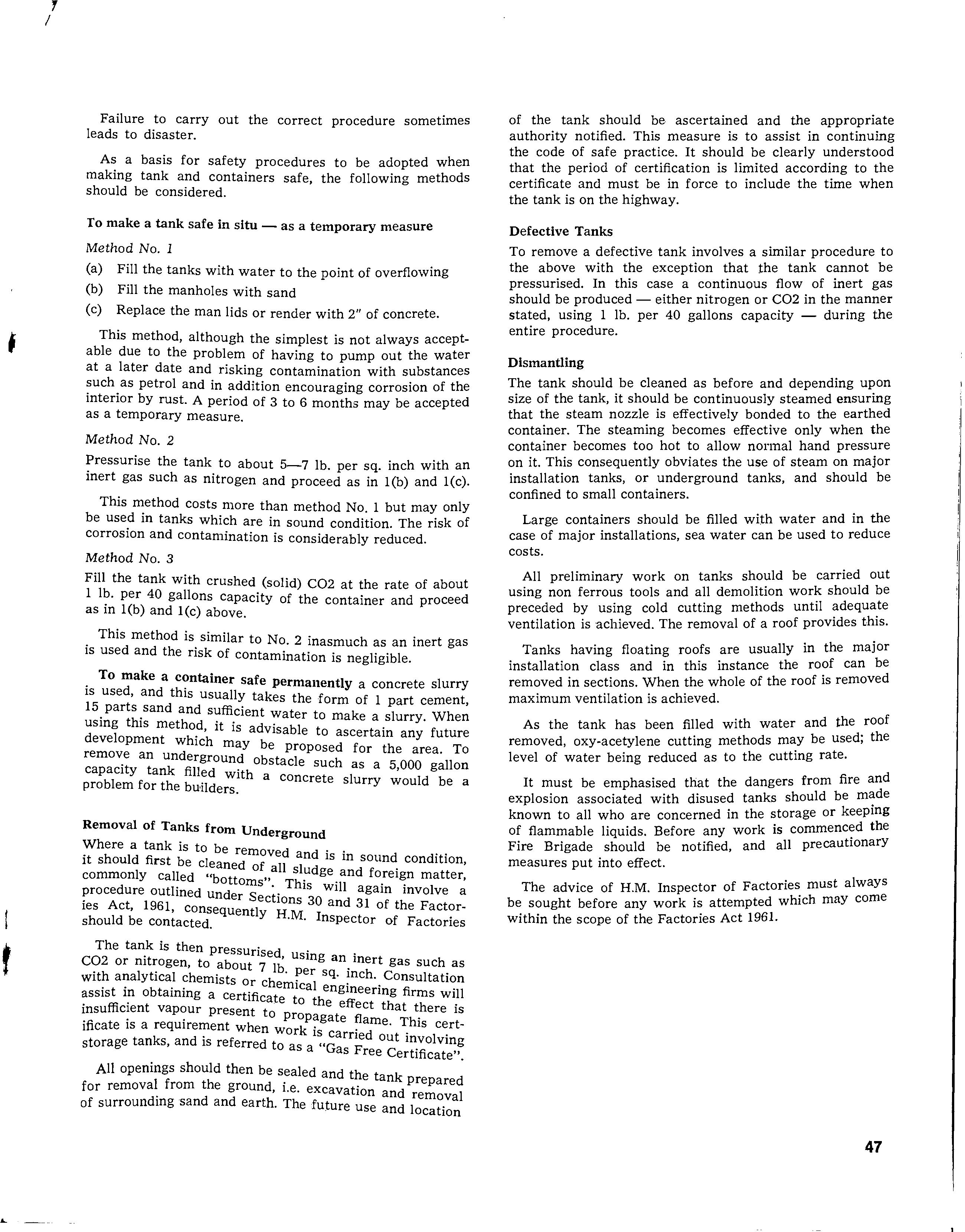
7 minute read
Safety Precautions
by apeauk
SAFETY PRECAUTIONSDISUSED TANKS
By A. HEWITT, Liverpool.
Advertisement
One of the Conditions of Licence for a petroleum spirit installation reads as follows :-
The licensee shall at least 10 days before discontinuing the use for the storage of petroleum of any underground tank or similar receptacle on the premises to which this licence relates, give to the Local Authority notice in writing of his intention to do so and shall immediately upon discontinuing its use, take such steps as may be necessary to render it immune from danger of fire or explosion, including any necessary steps which the Local
Authority may require him to take for that purpose.
Incidents involving the cleaning. removal, dismantling or conveyance of storage tanks which have previously contained flammable liquids are infrequent, but due to the limited safety precautions which are sometimes applied in these circumstances, such events are invariably accompanied by serious injury or loss of life.
The problems relating to making a tank safe, in order to carry out repairs or fulfil a Condition of Licence, are dependent upon a number of factors, each contributing to the dangers associated with fire and explosion. Apart from the obvious things such as an explosive mixture and a means of ignition, consideration must be given to :(a) Legislation (b) The commodity which is stored (c) The procedure to be adopted for each particular operation.
Legislation Before applying any Codes of Good Practice or making recommendations regarding safety precautions, careful examination of any legislation associated with the work should be examined and the relative authorities contacted. Consultation with H.M. Inspector of Factories will reveal any special requirements made under Sections 30 and 31 of the Factories Act 1961. However, in this case I would mention the Safety, Health and Welfare Booklet No. 32, published by the Department of Employment and Productivity in conjunction with H.M. Factories Inspectorate and Technical Data Note No. 18 "Repair and Demolition of Large Storage Tanks" (H.M. Factory Inspectorate).
Harbour Authorities are Licensing Authorities in their own right and in this case shipping regulations may well be involved and liaison with the Board of Trade is called for. The Commodity being Stored and Volatility The controlling factors here are Flash Point, Viscosity, and once again the particular legislation which may affect the substance should be examined.
Although flash points have been used to separate various flammable liquids into categories, a general guide might be as follows:
Low Flash Point - Below 73°F (Petroleum Spirit) 73°F-90°F (Factories Act) Medium - 90°F-150°F.
Insofar as safety is concerned, a serious fire or explosion can be just as devastating whether caused by the ignition of vapours from a high or Iow flash commodity. With this in mind it follows that the most stringent precautions should be applied when working on any container known to have been used for storage of flammable liquid.
Prior to 1951 D.S.I.R., J.F.R.O. and Fire Offices Committee performed a number of experiments on various sizes of drums containing small amounts of fuel oil including paraffin and diesel. By raising the temperatures above that of flash point, they were able to produce explosions.
To my mind this points to many complications such as "flash back" and a spread of fire over large areas.
How is the Commodity Stored? This may be either above or below ground, and from time to time all containers whether large or small require a certain amount of maintenance. SpeCial precautions are laid down in the Factories Act Sections 30 and 31 regarding dangerous fumes. lack of oxygen, and safety measures with respect to explosive or flammable gas, vapour or substance. This brings me to the main topic for discussion.
The Procedure to be Adopted Nearly all forms of instruction in connection with safety are built around a procedure, e.g.
Road Safety - LOOK RIGHT! LOOK LEFT! LOOK RIGHT AGAIN and if the road is clear walk quickly across. Fire Safety - On discovery of fire SOUND THE ALARM LEAVE THE BUILDING CALL THE FIRE BRIGADE.

Failure to carry out the correct procedure sometimes leads to disaster.
As a basis for safety procedures to be adopted when making tank and containers safe, the following methods should be considered.
To make a tank safe in situ - as a temporary measure
Method No. 1 (a) Fill the tanks with water to the point of overflowing (b) Fill the manholes with sand (c) Replace the man lids or render with 2" of concrete.
This method, although the simplest is not always acceptable due to the problem of having to pump out the water at a later date and risking contamination with substances as petrol and in addition encouraging corrosion of the mtenor by rust. A period of 3 to 6 months may be accepted as a temporary measure.
Method No. 2 the tank to about 5-7 lb. per sq. inch with an mert gas such as nitrogen and proceed as in 1(b) and l(c).
This costs more than method No. 1 but may only be m tanks which are in sound condition. The risk of corrOSIOn and contamination is considerably reduced. Method No. 3 Fill the tank with crushed (solid) C02 at the rate of about 1 I? per 40 gallons capacity of the container and proceed as m l(b) and l(c) above.
. This method is similar to No. 2 inasmuch as an inert gas IS used and the risk of contamination is negligible. . IS To make a containe f r sa e permanently a used, and this usu II t k a y a es the form of concrete slurry 1 part cement and sufficient water to make a slurry d usmgl IS method, it is advisable to ascertain any· future eve opment which may b remove an Und e proposed for the area. To capacity tank erground Obstacle filled with such as 5 000 a, 11 ga on problem for the bUilders. a concrete slurry would be a
Removal of Tanks from U d n erground Where a tank is to be rem . . it should first be cleaned and IS m sound condition, commonly called procedure outlined "bott 0 "a sludge and foreign matter, oms . This w·n .. under S. I agam mvolve a ies Act, 1961, consequenuectlOns 30 and 31 of the Factorshould be contacted. y H.M. Inspector of Factories
The tank is then pressu· d . rIse C02 or mtrogen, to about 7 Ib using . an. mert gas such as with analytical chemists or ch . sq. Consultation assist in obtaining a certificatem;caI engmeering firms will insufficient vapour present to e 0 the effect that there is ificate is a requirement when This certstorage t k an s, d an . IS referred to as IS carned a "G F out in 1· vo vmg as ree Certificate".
All openings should then be sealed and th t for removal from the ground, i.e. ankdPrepared of dsurroun · mg d san and earth. The futUre . use an removal d 1 . an ocatlOn of the tank should be ascertained and the appropriate authority notified. This measure is to assist in continuing the code of safe practice. It should be dearly understood that the period of certification is limited according to the certificate and must be in force to include the time when the tank is on the highway.
Defective Tanks To remove a defective tank involves a similar procedure to the above with the exception that the tank cannot be pressurised. In this case a continuous flow of inert gas should be produced - either nitrogen or C02 in the manner stated, using 1 lb. per 40 gallons capacity - during the entire procedure.
Dismantling The tank should be cleaned as before and depending upon size of the tank, it should be continuously steamed ensuring that the steam nozzle is effectively bonded to the earthed container. The steaming becomes effective only when the container becomes too hot to allow normal hand pressure on it. This consequently obviates the use of steam on major installation tanks, or underground tanks, and should be confined to small containers.
Large containers should be filled with water and in the case of major installations, sea water can be used to reduce costs.
All preliminary work on tanks should be carried out using non ferrous tools and all demolition work should be preceded by using cold cutting methods until adequate ventilation is achieved. The removal of a roof provides this.
Tanks having floating roofs are usually in the major installation class and in this instance the roof can be removed in sections. When the whole of the roof is removed maximum ventilation is achieved.
As the tank has been filled with water and the roof removed, oxy-acetylene cutting methods may be used; the level of water being reduced as to the cutting rate.
It must be emphasised that the dangers from fire and explosion associated with disused tanks should be made known to all who are concerned in the storage or keeping of flammable liquids. Before any work is commenced the Fire Brigade should be notified, and all precautionary measures put into effect.
The advice of H.M. Inspector of Factories must always be sought before any work is attempted which may come within the scope of the Factories Act 1961.







